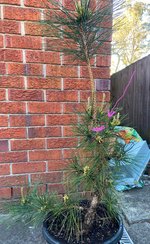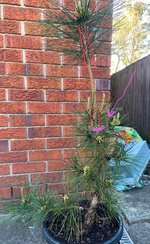TimIAm
Mame
I want to keep the sacrifice going on this tree for now, but I do not know if, what or when I should be removing candles or buds or anything else from the sacrifice for the best possible outcome. Aim is to continue to thickening the base while maintaining vigor below the eventual cut point.
Picture of tree. Pink arrow points to pink line where eventual top will be once the sacrifice is removed.

Picture showing the a closeup of the area where I eventually plan to have as the top.

Last picture shows the top of the sacrifice branch:

I'd also appreciate if someone can tell me how to refer to the parts growing around the base of the candles? Are they called buds or something else?
- In the second picture, just above the eventual top, do I need to remove anything or everything that is not needed around the sacrifice?
- In the picture of the top just above, do I need to remove everything except for a single candle?
- When or should I remove all of the needles around the base of the current top? I assume the candle(s) above will extend and I will have more needles above by mid summer.
My questions are based on seeing pines with a single tall sacrifice, I have no real idea of what I'm doing, just trying to copy what I see while I build an understanding. So my questions may be way off the mark.
Picture of tree. Pink arrow points to pink line where eventual top will be once the sacrifice is removed.

Picture showing the a closeup of the area where I eventually plan to have as the top.

Last picture shows the top of the sacrifice branch:

I'd also appreciate if someone can tell me how to refer to the parts growing around the base of the candles? Are they called buds or something else?
- In the second picture, just above the eventual top, do I need to remove anything or everything that is not needed around the sacrifice?
- In the picture of the top just above, do I need to remove everything except for a single candle?
- When or should I remove all of the needles around the base of the current top? I assume the candle(s) above will extend and I will have more needles above by mid summer.
My questions are based on seeing pines with a single tall sacrifice, I have no real idea of what I'm doing, just trying to copy what I see while I build an understanding. So my questions may be way off the mark.


